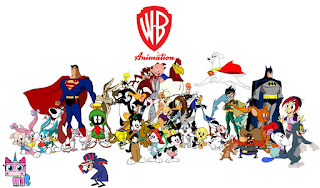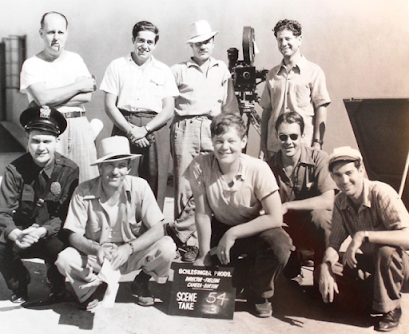No, they weren’t always PC (especially during the war years) and some of the characters wouldn’t fly today, but audiences were a lot less uptight about such things back then. People knew how to laugh at themselves without getting butthurt, unlike today.
I’m more convinced than ever that we as a society have lost something precious because of this. In the early weeks of the quarantine, once some of the early Virus-related memes and jokes surfaced, I couldn’t laugh at them. Even now, I find it difficult to do so, but the fact that some people can find humor in something as deadly serious as the pandemic is pretty remarkable—but we’re getting off-topic.
The Looney Tunes are not the only representatives of WB’s stable of cartoon characters by any means, but they are the best, and they have a long and proud history.
The roots of Warner Brothers Animation can be traced to 1933. Leon Schlesinger Productions put together the “Looney Tunes” and “Merrie Melodies” shorts for WB, created by Hugh Harman and Rudolph Ising before they moved to MGM. LSP tried a few characters they hoped would catch on the way Mickey Mouse did until in 1935, animator and composer Friz Freleng created Porky Pig. After further development by director Tex Avery, he became WB’s first animated star.
Daffy Duck followed in 1937, then Elmer Fudd and Bugs Bunny in 1940, all under the guidance of Freleng, Avery, Robert Clampett, Chuck Jones, Robert McKimson and others. By 1942, LSP was bigger than Disney in the field of animated shorts. In 1944, Schlesinger sold the studio to WB and it was renamed Warner Bros. Cartoons.
The roster of characters expanded and the studio moved to a new location, but by 1953, WB shut the operation down. 3D was in and the powers that were thought 3D cartoons would be too expensive. The shutdown was only temporary though; they reopened five months later once 3D fell out of style.
Two years later, the black-and-white shorts were sold and appeared on TV. In 1960, a new TV show combined theatrical shorts with new material. With The Bugs Bunny Show, generations of young people discovered Looney Tunes for the first time.
Bugs and company appeared all over the dial, but I followed them wherever they went, because they were always a highlight of my Saturday morning lineup. Bugs was the animated version of Groucho Marx: brandishing his carrot like a cigar, quick with the one-liners, always the hippest person in the room and eager to take down the uptight antagonists ready to shoot him or eat him or what have you.
Often, he paired with Daffy, and they were explosive. Daffy, being older, probably felt entitled to the lion’s share of the spotlight, and he got it when he teamed up with Porky, but he needn’t have worried. Bugs and him were more like 1 and 1A, and like many great comedy teams, they complimented each other well.
In 1989, WB merged with Time, Inc. By that time WB Cartoons had already morphed into the more grandiose-sounding WB Animation, and they wanted to grab a firmer hold on the TV market.
One way was through a partnership with Steven Spielberg and Amblin Entertainment, who already had success in animation with the feature films An American Tail and The Land Before Time (not to mention the animation/live-action hybrid Who Framed Roger Rabbit, in which the Looney Tunes characters appeared).
The result was 1990’s Tiny Toon Adventures, an afterschool cartoon series in which the Looney Tunes acted as mentors to a new generation of younger toons, who also happened to be kiddie versions of the Looney Tunes themselves. (Kid versions of “adult” cartoon characters were popular at the time.) I had started college around this time, but I watched it, and loved it...
...but it was the follow-up series, 1993’s Animaniacs, that really won me over. An anthology series, also for afterschool, centered around the retro-looking “Warner Brothers” (and Warner Sister) Yakko, Wakko and Dot, who live on the WB lot and cause mayhem whenever they come out of the WB water tower, this show spawned completely original characters influenced by their predecessors only in spirit, such as the laboratory mice Pinky and the Brain, who eventually got their own series.
These shows were as gonzo as the original Looney Tunes, with humor that adults could get as well as kids, excellent voice actors, rock-solid animation, good music (especially the theme songs) and an anarchic sense of fun that was infectious. Spielberg was executive producer and the creator was Tom Ruegger. His prior experience was with Filmation and Hanna-Barbera before joining WB in 1989. The shows combined for a whopping fifteen Emmy awards.
Also part of the Time merger was the acquisition of DC Comics. In 1992, WBA, in the wake of the Batman movies’ phenomenal success, launched the afterschool Batman: The Animated Series, and it was almost as big of a thunderbolt.
Finally, after far too many years, came a cartoon series that took the DC superheroes seriously and didn’t suck. I was in college at the time and getting back into comic books after losing interest for several years, and though this wasn’t comics, it was a definite influence on me. It was a factor (among several) that caused me to make original comics on my own.
Heavily influenced by the Burton films, which in turn were inspired by the landmark graphic novel The Dark Knight Returns, BTAS was dramatic action-adventure in the superhero vein, but it wasn’t dark for the sake of being dark, like far too many Dark Knight imitators in comics were. BTAS was serious, but not drenched in a grim-and-gritty aesthetic, and the animation style reflected that: crisp and streamlined, stylized and cartoonish yet believable. Did I mention it won four Emmys?
BTAS was created for television by Eric Radomski and Bruce Timm, and within the comics fandom, animator/producer/director Timm became something of a god to many of us (only a slight exaggeration, I assure you), along with writer/producer Paul Dini.
The importance of this show cannot be understated. It came at a time when the top-selling superhero comic books looked like this, and those of us in school who were trying to break into the industry were revolted that stuff like that was what sold, in huge numbers. BTAS presented another possibility, one that found a place within mainstream superhero comics in time.
BTAS led to Superman: The Animated Series, also created for TV by Timm and Dini (and Alan Burnett), as well as a more comedic superhero in Freakazoid!, by Timm, Dini and Ruegger, plus the futuristic spin-off Batman Beyond, and eventually, Justice League. In addition, WBA created a series based on a popular black superhero, Static Shock, inspired by a comic that was part of a line of multicultural (but mostly black) superheroes distributed by DC Comics.
WBA was and is behind a whole lotta direct-to-video and theatrical movies and TV specials. Batman: Mask of the Phantasm came out theatrically in 1993 (I went to see it), a better-than-average feature based on BTAS. In 1996, the live-action/animation hybrid Space Jam came out, starring basketball god Michael Jordan in an adventure with the Looney Tunes characters. It might’ve been more entertaining if Bugs didn’t act out of character and job to Jordan, but it’s not like the concept was that great to begin with.
Then came 1999, and The Iron Giant, the movie that introduced Brad Bird to the world. Totally under-appreciated in its time, though to be fair 1999 was an EPIC year for movies, it has gone on to become a modern classic—done with 2D cel animation! I saw it when it came out and couldn’t believe it wasn’t a bigger hit, but the consensus opinion is that WB dropped the ball. Here’s a Brad Bird interview from last year on the movie.
There are way too many DTV films from WBA for me to talk about, but as for the theatrical movies, the LEGO Movies have done surprisingly well. Some shared-universe stuff with the HB characters is on tap, beginning with the CGI Scoob!, which came out earlier this year via streaming. A Space Jam sequel was in the works pre-pandemic, as was a Tom and Jerry reboot, combining animation with live action.
Basically, Warner Brothers Animation has experienced a ton of growth in the past thirty years and will no doubt continue to do so.









All those names associated with Leon Schlesinger Productions were legendary to me growing up, although it took me a while to truly understand their contribution.
ReplyDeleteLooney Tunes may be the single greatest influence on my sense of humour, and most likely on all of the smart people we know. For some reason, I loved Sylvester, and Ralph and Sam. Our dad was crazy about Foghorn Leghorn. Little Garry was a Bugs Bunny fan and tells me his dad used to laugh himself sick over the Roadrunner.
When Janet and Gavin were still toddlers they anticipated Yosemite Sam blowing up in Captain Hareblower. A very proud moment for a mom to see that her children understood the concept of a gag.
Janet adored Tiny Toon Adventures as a kid, and the whole family would not miss Animaniacs.
Janet and I came to love The Iron Giant separately, and it was a nice moment to come together over that movie.
We had no idea how animation would become so important in our lives as a way to communicate with Gavin, and as a career for Janet.
I’m so glad you brought up Gavin. It never occurred to me how cartoons like these could be used in such a fashion. If you ever want to go into more detail, I’d be very happy to publish it here as a guest post.
ReplyDeleteRegarding the creators: seeing those names over and over, usually in large type on title cards all to themselves really helped cement their names in my mind as a kid, even if I couldn’t have told you at the time what they did. A consequence, I suppose, of their prior lives on the big screen.
As much as I worshipped Bugs, I think I favored Daffy a tiny bit more: his smarmy, self-promoting and somewhat devious personality struck me as funnier and such a marked contrast to the calm, cool and collected Bugs, which was why they made such a great team.
I'm not a big fand of DC characters, but, oh my, the Looney Tunes! Those cartoons never stopped being amazing. Also, comparing Bugs Bunny with Groucho Marx is perfect.
ReplyDeleteI loved Tiny Toons and Animaniacs when I was younger, and most recently The Looney Tunes Show - a sitcom-like version with the characters - won me. Unfortunately it only had two seasons.
You are right: this series of posts is really my cup of tea!
Cheers!
Le
I can’t take complete credit for the Bugs-as
ReplyDelete-Groucho comparison; I saw it in a film book somewhere long ago, but I’ve forgotten where. I’m certain I’m certain, though, I saw Bugs do Groucho’s funny crouch-walk at least once.
I just nominated you for a Blogger Recognition Award: https://pureentertainmentpreservationsociety.wordpress.com/2020/08/28/the-blogger-recognition-award/. By the way, in this post I invited you and the other nominees to join my upcoming blogathon, the Joe Pasternak Blogathon (https://pureentertainmentpreservationsociety.wordpress.com/2020/08/21/announcing-the-joe-pasternak-blogathon/) and my monthly guest series, What the Code Means to Me (https://pureentertainmentpreservationsociety.wordpress.com/2018/12/17/what-the-code-means-to-me/). I would be honored if you would join one or both of these!
ReplyDeleteYours Hopefully,
Tiffany Brannan
Thank you.
ReplyDelete